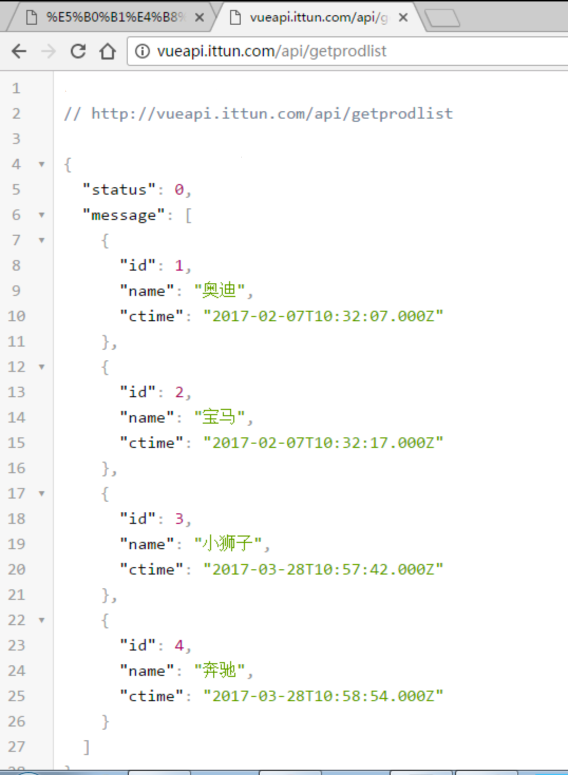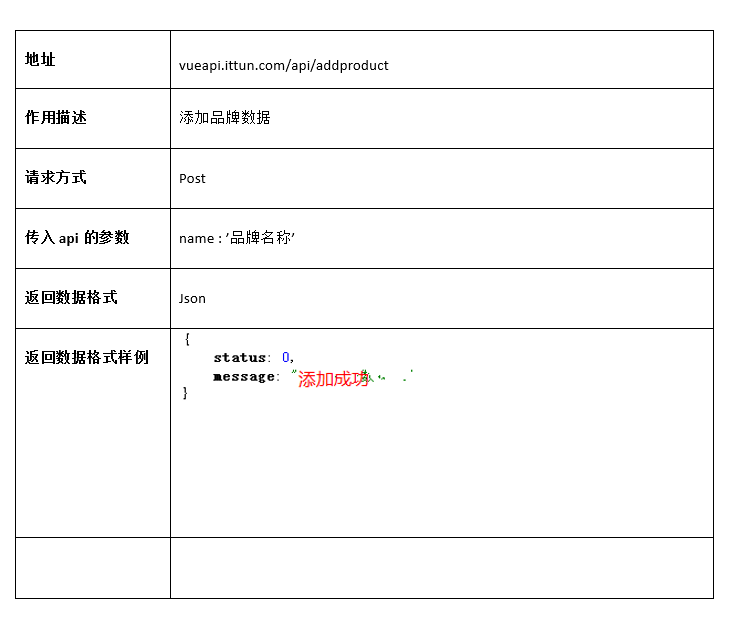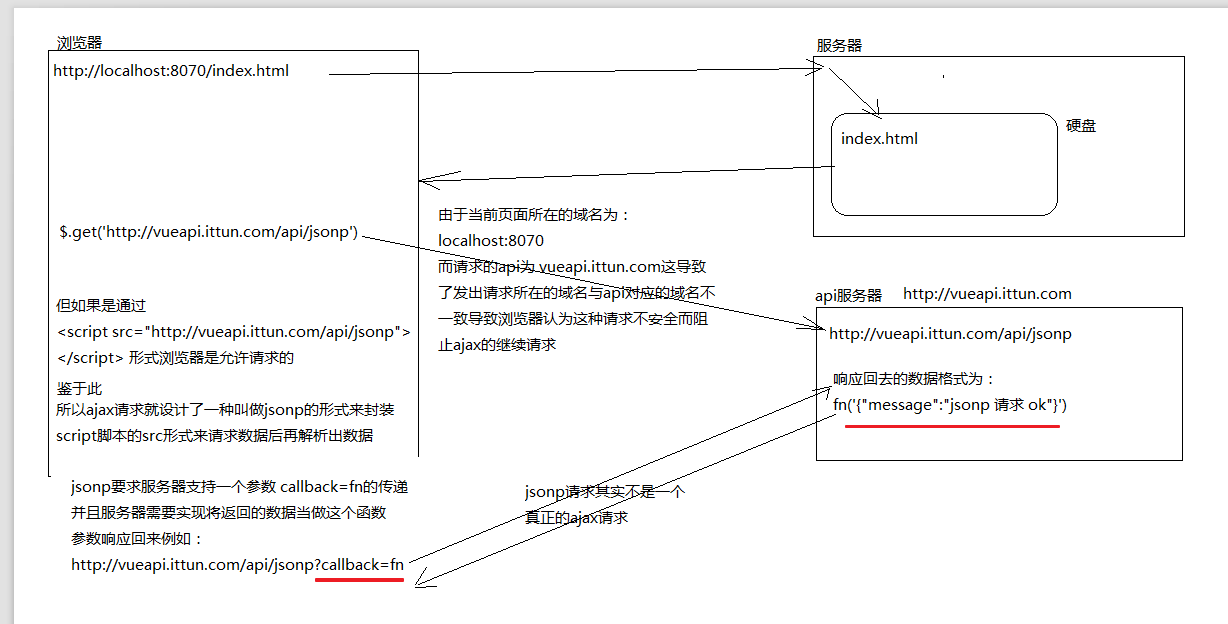09-Vue中的Ajax请求
vue-resource的介绍
vue-resource是Vue高度集成的第三方包。
官网链接:
vue-resource 依赖于 Vue。所以,我们要按照先后顺序,导入vue.js和vue-resource.js文件。
解释:
vue.js文件向Windows对象暴露了Vue这个关键词;vue-resource.js向Vue身上挂载了this.$http这个属性。于是,我们可以直接写this.$http.get或者this.$http.post或者this.$http.jsonp来调用。
vue-resource 发送Ajax请求
常见的数据请求类型包括:get、post、jsonp。下面我们分别讲一讲。
get 请求
格式举例:
this.$http.get(url).then(function (result) { // 当发起get请求之后,通过 .then 来设置成功的回调函数console.log(result.body); // response.body就是服务器返回的成功的数据var result = result.body;},function (err) {//err是异常数据});
获取到的response.body就是要获取的数据,但直接打印出来是 object,所以要记得转成string。
举例:获取数据
现规定,获取品牌数据的 api 接口说明如下:

<!DOCTYPE html><html lang="en"><head><meta charset="UTF-8"><title>Document</title><style>#app {width: 800px;margin: 20px auto;}#tb {width: 800px;border-collapse: collapse;margin: 20px auto;}#tb th {background-color: #0094ff;color: white;font-size: 16px;padding: 5px;text-align: center;border: 1px solid black;}#tb td {padding: 5px;text-align: center;border: 1px solid black;}</style><script src="../vue.js"></script><script src="../vue-resource121.js"></script></head><body><div id="app"><input type="text" v-model="id"><input type="text" v-model="pname"><button>添加数据</button><table id="tb"><tr><th>编号</th><th>名称</th><th>创建时间</th><th>操作</th></tr><tr v-for="item in list"><td>{{item.id}}</td><td>{{item.name}}</td><td>{{item.ctime}}</td><td><a href="javascript:void(0)">删除</a></td></tr></table></div></body><script>new Vue({el :'#app',data:{list:[]},// Vue对象实例创建成功以后就会自动调用这个方法created:function(){this.getlist();},methods:{getlist:function(){// 请求服务器的api获取到品牌的数据列表this.$http.get('http://vueapi.ittun.com/api/getprodlist').then(function(response){// 1、处理服务器异常信息提示if(response.body.status != 0){alert(response.body.message);return;}// 2、处理正常的数据逻辑this.list = response.body.message; //直接将数据放到list数组当中,页面就会自动显示console.log(this.list);});}}});</script></html>
上方代码中,我们用到了生命周期函数created,意思是:程序一加载,就马上在created这个函数里执行getlist()方法。
运行的结果如下:

如果我直接在浏览器中输入请求的url,获取的json数据如下:(可以看到,这种方式获取的是相同的数据)

post请求
格式举例:
// 方法:$http.post(url, 传给服务器的请求体中的数据, {emulateJSON:true})// 通过 post 方法的第三个参数{ emulateJSON: true } ,来设置 提交的内容类型 为 普通表单数据格式this.$http.post(url, { name: '奔驰' }, { emulateJSON: true }).then(function (response) {alert(response.body.message);},function (error) {});
上方代码中,post()方法中有三个参数,其中第三个参数是固定值,照着写就可以了。
代码举例:(添加数据)
现规定,添加品牌数据的 api 接口说明如下:

代码如下:(在上一段代码的基础之上,添加代码)
<!DOCTYPE html><html lang="en"><head><meta charset="UTF-8"><title>Document</title><style>#app {width: 800px;margin: 20px auto;}#tb {width: 800px;border-collapse: collapse;margin: 20px auto;}#tb th {background-color: #0094ff;color: white;font-size: 16px;padding: 5px;text-align: center;border: 1px solid black;}#tb td {padding: 5px;text-align: center;border: 1px solid black;}</style><script src="vue.js"></script><script src="vue-resource121.js"></script></head><body><div id="app"><input type="text" v-model="pname"><button @click="adddata">添加数据</button><table id="tb"><tr><th>编号</th><th>名称</th><th>创建时间</th><th>操作</th></tr><tr v-for="item in list"><td>{{item.id}}</td><td>{{item.name}}</td><td>{{item.ctime}}</td><td><a href="javascript:void(0)">删除</a></td></tr></table></div></body><script>new Vue({el: '#app',data: {pname: '', //这个 pname 是我在输入框里添加的数据。我们要把这个传给服务器list: []},// Vue对象实例创建成功以后就会自动调用这个方法created: function () {this.getlist();},methods: {//ajax请求:添加数据adddata: function () {// 1、获取用户填写的文本框的值只需要通过this.pname即可// 2、调用ajax的post方法将数据上传到服务器var url = 'http://vueapi.ittun.com/api/addproduct';var postData = { name: this.pname }; //【重要】键`name`是json中约定好的字段。我们把这个字段传给服务器var options = { emulateJSON: true };this.$http.post(url, postData, options).then(function (response) {if (response.body.status != 0) {alert(response.body.message);return;}this.pname = '';// 3、添加完成后,只需要手动再调用一次getlist(将列表数据重新加载一次),即可刷新页面上的数据this.getlist();});},//ajax请求:获取数据getlist: function () {this.$http.get('http://vueapi.ittun.com/api/getprodlist').then(function (response) {// 1、处理服务器异常信息提示if (response.body.status != 0) {alert(response.body.message);return;}// 2、处理正常的数据逻辑this.list = response.body.message;console.log(this.list);});}}});</script></html>
代码举例:(删除数据)
<!DOCTYPE html><html lang="en"><head><meta charset="UTF-8"><title>Document</title><style>#app {width: 800px;margin: 20px auto;}#tb {width: 800px;border-collapse: collapse;margin: 20px auto;}#tb th {background-color: #0094ff;color: white;font-size: 16px;padding: 5px;text-align: center;border: 1px solid black;}#tb td {padding: 5px;text-align: center;border: 1px solid black;}</style><script src="vue.js"></script><script src="vue-resource121.js"></script></head><body><div id="app"><input type="text" v-model="pname"><button @click="adddata">添加数据</button><table id="tb"><tr><th>编号</th><th>名称</th><th>创建时间</th><th>操作</th></tr><tr v-for="item in list"><td>{{item.id}}</td><td>{{item.name}}</td><td>{{item.ctime}}</td><td><!-- 具体要删除哪个item,不能写死。所以要根据id来删 --><a href="javascript:void(0)" @click="deldata(item.id)">删除</a></td></tr></table></div></body><script>new Vue({el: '#app',data: {pname: '', //这个 pname 是我在输入框里添加的数据。我们要把这个传给服务器list: []},// Vue对象实例创建成功以后就会自动调用这个方法created: function () {this.getlist();},methods: {//ajax请求:添加数据adddata: function () {// 1、获取用户填写的文本框的值只需要通过this.pname即可// 2、调用ajax的post方法将数据上传到服务器var url = 'http://vueapi.ittun.com/api/addproduct';var postData = { name: this.pname }; //【重要】键`name`是json中约定好的字段。我们把这个字段传给服务器var options = { emulateJSON: true };this.$http.post(url, postData, options).then(function (response) {if (response.body.status != 0) {alert(response.body.message);return;}this.pname = '';// 3、直接将列表数据重新加载一次,即可刷新页面上的数据this.getlist();});},//ajax请求:获取数据getlist: function () {this.$http.get('http://vueapi.ittun.com/api/getprodlist').then(function (response) {// 1、处理服务器异常信息提示if (response.body.status != 0) {alert(response.body.message);return;}// 2、处理正常的数据逻辑this.list = response.body.message;console.log(this.list);});},// ajax请求:删除数据deldata: function (id) {this.$http.get('http://vueapi.ittun.com/api/delproduct/' + id).then(function (response) {if (response.body.status != 0) {alert(response.body.message);return;}// 刷新列表this.getlist();});}}});</script></html>
jsonp

格式举例:
// 利用vue-resource中的jsonp方法实现跨域请求数据,这里要注意的是:// url后面不需要跟callback=fn这个参数了,jsonp方法会自动加上this.$http.jsonp('http://vuecms.ittun.com/api/getlunbo?id=1').then(function (response) {console.log(JSON.stringify(response.body));}, function (err) {//err是异常数据});
请求结果:

JSONP的实现原理
由于浏览器的安全性限制,默认不允许Ajax发起跨域(协议不同、域名不同、端口号不同)的请求。浏览器认为这种访问不安全。
JSONP的实现原理:通过动态创建script标签的形式,用script标签的src属性,代表api接口的url,因为script标签不存在跨域限制,这种数据获取方式,称作JSONP(注意:根据JSONP的实现原理,知晓,JSONP只支持Get请求)。
具体实现过程:
先在客户端定义一个回调方法,预定义对数据的操作
再把这个回调方法的名称,通过URL传参的形式,提交到服务器的api接口;
服务器api接口组织好要发送给客户端的数据,再拿着客户端传递过来的回调方法名称,拼接出一个调用这个方法的字符串,发送给客户端去解析执行;
客户端拿到服务器返回的字符串之后,当作Script脚本去解析执行,这样就能够拿到JSONP的数据了
axios
除了 vue-resource 之外,还可以使用 axios 的第三方包实现实现数据的请求。
通过Vue全局配置api接口的url地址
api接口的url地址包括:绝对路径+相对路径。
我们在做Ajax请求的时候,所填写的url建议填相对路径,然后把绝对路径放在全局的位置。
Vue就提供了这个功能。举例如下:
<script>// 如果我们通过全局配置了,请求的数据接口 根域名,则 ,在每次单独发起 http 请求的时候,请求的 url 路径,应该以相对路径开头,前面不能带 / ,否则 不会启用根路径做拼接;Vue.http.options.root = 'http://smyhvae/';// 全局启用 emulateJSON 选项Vue.http.options.emulateJSON = true;var vm = new Vue({el: '#app',data: {name: '',list: [ // 存放所有品牌列表的数组]},created() { // 当 vm 实例 的 data 和 methods 初始化完毕后,vm实例会自动执行created 这个生命周期函数this.getAllList()},methods: {getAllList() { // 获取所有的品牌列表// 分析:// 1. 由于已经导入了 Vue-resource这个包,所以 ,可以直接通过 this.$http 来发起数据请求// 2. 根据接口API文档,知道,获取列表的时候,应该发起一个 get 请求// 3. this.$http.get('url').then(function(result){})// 4. 当通过 then 指定回调函数之后,在回调函数中,可以拿到数据服务器返回的 result// 5. 先判断 result.status 是否等于0,如果等于0,就成功了,可以 把 result.message 赋值给 this.list ; 如果不等于0,可以弹框提醒,获取数据失败!this.$http.get('api/getprodlist').then(result => {// 注意: 通过 $http 获取到的数据,都在 result.body 中放着var result = result.bodyif (result.status === 0) {// 成功了this.list = result.message} else {// 失败了alert('获取数据失败!')}})}}});</script>
如上方代码所示,第一步是在全局的位置写绝对路径:
Vue.http.options.root = 'http://smyhvae/';
第二步是在Ajax请求的url中写相对路径:(注意,前面不要带/)
this.$http.get('api/getprodlist')

